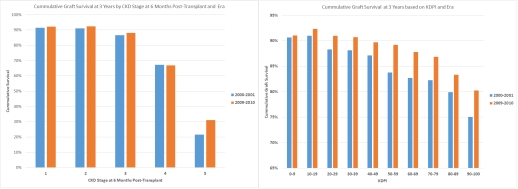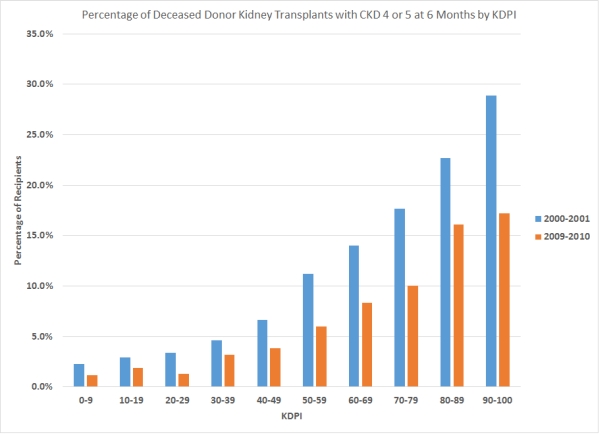Improvement in Intermediate Graft Survival among Deceased Donor Recipients in the Last Decade Due to Improvements in Outcomes of Higher KDPI Kidney Recipients
Medicine, Sacred Heart Hospital, Pensacola, FL, Turkey.
Meeting: 2018 American Transplant Congress
Abstract number: D74
Keywords: Donors, Graft survival, Immunosuppression, Kidney transplantation, marginal
Session Information
Session Name: Poster Session D: Kidney Complications: Late Graft Failure
Session Type: Poster Session
Date: Tuesday, June 5, 2018
Session Time: 6:00pm-7:00pm
 Presentation Time: 6:00pm-7:00pm
Presentation Time: 6:00pm-7:00pm
Location: Hall 4EF
Previous research by our group showed that intermediate graft survival of adult deceased donor kidney transplants between six months and three years post-transplant improved in the latter half of last decade (2005-2010) in the US.1 That improvement in longer-term outcomes occurred in the setting of a consolidation of a number of different immunosuppressive combinations to over 85% of recipients receiving tacrolimus and mycophenolate derivative immunosuppression.
| Discharge Maintenance Immunosuppression | 2000-2001 | 2009-2010 |
| Tacrolimus and MPA Derivative | 37.6% | 86.9% |
| Cyclosporine and MPA Derivative | 33.4% | 3.8% |
| CNI and mTOR Inhibitor | 9.4% | 1.2% |
| CNI and Azathioprine | 5.0% | 0.5% |
| Other Combination | 14.2% | 7.6% |
The improvement in graft survival was associated with an improvement in the average eGFR attained at 6 months post-transplant. In order to better understand how this improvement in graft survival occurred, all adult deceased donor recipients in the SRTR database in two eras (2000-2001 and 2009-2010) based on the KDPI of the donor and eGFR attained at 6 months were analyzed. Stratifying for CKD stage, Kaplan Meier analysis showed little difference in graft survival of between recipients transplanted in the two eras. On the other hand stratifying by KDPI showed that graft survival improved most dramatically in those recipients that received an allograft with higher KDPI. The improvement was associated with much lower percentage of patients with CKD 4 or 5 at six months post-transplant in the latter era.
The improvement was associated with much lower percentage of patients with CKD 4 or 5 at six months post-transplant in the latter era. This data suggests that the improvement associated with the pervasive use of tacrolimus and mycophenolate derivative immunosuppression was due in part to better eGFR in higher KDPI kidneys.
This data suggests that the improvement associated with the pervasive use of tacrolimus and mycophenolate derivative immunosuppression was due in part to better eGFR in higher KDPI kidneys.
1Keith et al, Tranplant Direct 2017;3(6).
CITATION INFORMATION: Keith D. Improvement in Intermediate Graft Survival among Deceased Donor Recipients in the Last Decade Due to Improvements in Outcomes of Higher KDPI Kidney Recipients Am J Transplant. 2017;17 (suppl 3).
To cite this abstract in AMA style:
Keith D. Improvement in Intermediate Graft Survival among Deceased Donor Recipients in the Last Decade Due to Improvements in Outcomes of Higher KDPI Kidney Recipients [abstract]. https://atcmeetingabstracts.com/abstract/improvement-in-intermediate-graft-survival-among-deceased-donor-recipients-in-the-last-decade-due-to-improvements-in-outcomes-of-higher-kdpi-kidney-recipients/. Accessed December 12, 2025.« Back to 2018 American Transplant Congress
